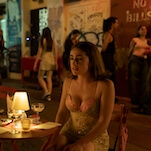Work Of Art: The Next Great Artist: "Judging A Book By Its Cover"

With its first unabashedly “commercial” challenge, Work Of Art makes clear that it won't be sticking to a high-minded, purist conception of the art world. The task is to create a cover for a classic book printed by Penguin, and while the judges try to rationalize it—hey, “Picasso did it!”—there’s no getting around the fact that this is a contract job to help Penguin hawk its public-domain wares. There’s nothing wrong with that. In fact, it’s a prestigious, exciting gig. But it is a departure from the first two episodes.
The artists are thrown by that shift, and most of them realize too late that their job is not to express some ineffable essence of books that they haven’t read, but rather to look good on a Borders endcap display. The producers structured the challenge quite nicely, assigning two artists to each book so that we could compare who had, say, the more compelling take on Dr. Jekyll And Mr. Hyde. The show’s best-laid plans are undone by lackluster performances from the artists, though, and the result is a meandering episode. The works are so mediocre that only two artists—Mark and John—are entered into consideration for a possible win, instead of the usual three.
Still, Work Of Art is a well-cast show, so there are a bunch of good character moments. Miles is assigned to create a cover for Frankenstein and dedicates half of his allotted studio time to reading the entire book. A commenter on last week’s post (checking … it was Falconback Horsery) made a strong argument that Miles is calculating his persona and dramatic flourishes in a meticulous, cutthroat effort to make himself an indispensable part of the show. I can see it, and I freaking love him for it.
For all the talk about Nao’s performance art, Miles seems to be the only one who’s aware that he’s working primarily in the medium of reality television. I agree with Noel’s take from last week that most of the contestants’ idiosyncrasies seem less put-on than they usually would in a reality show, given that artists are often eccentric anyway. But Miles, he’s playing this game hard, even if that simply means accentuating his natural quirks. Every week he has a new wrinkle for the cameras, and the producers lap it right up. Surely they know they’re being manipulated, and they don’t care. Did Miles really read the entire book in his little hidey-hole? Tough to say—his review (“really good,” “so amazing”) is pretty vague. No matter, because by then it’s time for his next elaborate trick: burning a piece of wood by starting an electrical fire. It doesn’t work, so he uses a Bic instead. If it were that easy, maybe he should have just started with the lighter. Except that wouldn’t have bought him two minutes of screen time.
Speaking of Nao, her bad-guy persona has fallen by the wayside. The other artists seem to like her a lot, and so do I. Her work is sophisticated and honest, and she’s always game to help her competitors with their projects. She’s not alone on that latter count. Work Of Art has a much more communal feel than its Bravo predecessors, which figures, since nobody’s ever heard of a designers’ commune or a chefs’ commune. The contestants on this show don’t hesitate to help each other out, nor are they afraid to criticize each other. Everyone takes it in stride, having settled in to the art-school vibe.
Abdi creates a clay sculpture for the first draft of his Frankenstein cover, but when he photographs the weird multicolored figure, it suddenly looks very drab. I empathized with this moment. Having done a fair amount of work in TV and video, I know what it’s like to create something that you think is really cool—a script, a prop, whatever—and then realize you’re in trouble the moment you see your work on camera. Some things seem to lose all life in the space between the lens and the viewfinder. (Sure, Abdi’s sculpture looked pretty amateurish to begin with, but don’t forget that we’re looking at it through the camera, too.) In any case, he recovers nicely, whipping out the spray paint and stencils for a stark cover that’s slapdash but striking, even if it does look kind of like Frankenstein’s monster is peeing blood.
Judith’s run comes to a merciful end—she has been ill at odds since the series began. Her work is the type of stuff that shows up at the local new-age store because the shopkeepers don’t know any better, but gets stuck in a back corner because they kind of do.
Meanwhile, John is a deserving winner, with a bold abstract rendition of a time machine for H.G. Wells’ The Time Machine. I didn’t have high hopes for John’s pink geometrical construction early on, but the addition of the tiny ladder was a brilliant touch, adding layers of whimsy and mystique that brought the concept home. Runner-up Mark’s Dracula cover was the opposite story. An early draft that features an inner-city skyline is modern and distinctive—Simon essentially tells him not to touch it—yet he dulls it down by replacing the cityscape with a generic blood treatment. I have no idea why the judges were so enamored with the blood dripping down into the “D” in Dracula. Looked really hokey to me.
I’m enjoying the judges more each week as they settle into their roles, even if Jeanne’s usually hilarious one-liners made a little too much sense for my taste this week. (I did enjoy/cringe at the moments where she tried to hide the fact that she had never read The Time Machine. She looked desperately to her fellow judges for affirmation as she ventured, “The Time Machine … is … the classic … science-fiction … novel…?”)








































